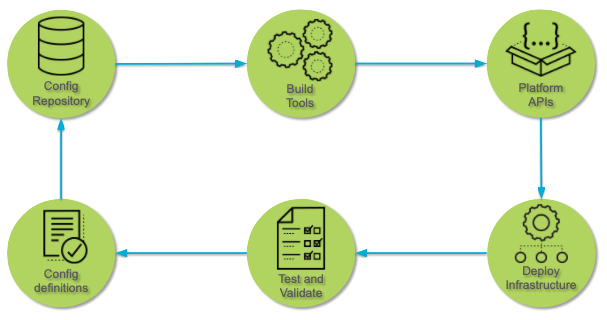Lab Introduction¶
Infrastructure as Code¶
This training lab provides hands-on exposure to Infrastructure as Code (IaC) concepts and practices. IaC simply stated is the practice of defining, utilizing, and maintaining infrastructure definitions as one would application source code.

- Config Definitions
Infrastructure deployments and their configurations can be defined in various languages. Terraform provides an infrastructure definition language called HCL that is multi-cloud in that it supports many different public and private cloud environments. Most IaC languages are declarative in nature. This means they define the desired state of the infrastructure rather than the steps necessary to achieve that state.
- Config Repository
A version control system (VCS) is a key element in managing application source code. Since infrastructure definitions are just another form of source code, a VCS is a key element of IaC environemts as well. It supports revision control, code checkout/checkin, team collaboration, code review, and API hooks for automated build tools.
- Build Tools
Build tools act on the infrastructure definitions to build and configure the infrastructure components. Often, this build process is incorporated into a larger Continuous Delivery (CD) pipeline with automated tests and gate factors that govern the build process.
- Platform APIs
In order to automate the deployment and configuration of infrastructure elements an API must be accessible to the build tool being used. Cloud providers such as AWS, GCP, and Azure all have various APIs supporting different infrastructure components and services. Third-party virtual appliances such as the VM-Series virtual firewall also has an API that may be used for configuration purposes. However, the use of a common infrastructure definition language and build tools all but eliminates the need to interact directly with any of these APIs.
- Deploy Infrastructure
The build tool is responsible for processing the infrastructure definition and leveraging the backend APIs and orchestrating the deployment the infrastructure components. Terraform accomplishes this by first assessing the state of each infrastructure resource. If nothing is instantiated, Terraform will take the necessary steps to deploy the resource and configure it based on the parameters that have been provided.
- Test and Validate
A set of tests may be performed to ensure that the deployed infrastructure aligns with the definitions provided in the infrastructure code. Since Terraform maintains state files detailing the live environment, it is easy to run a
terraform plancommand to identify and resolve and disparties.
Lab Topology¶
The following diagram details the infrastructure topology associated with the web
application we will be deploying. The VM-Series firewall will be used to inspect
and protect “North-South” traffic between the untrust and web zones as well
as “East-West” traffic between the web and database zones.

Subnet |
Address |
Interface |
|---|---|---|
Management |
10.5.0.0/24 |
Management |
Untrust |
10.5.1.0/24 |
ethernet1/1 |
Web |
10.5.2.0/24 |
ethernet1/2 |
Database |
10.5.3.0/24 |
ethernet1/3 |
Lab Components¶
- Qwiklabs
This lab is launched using Qwiklabs, which is an online learning platform that deploys and provides access to cloud-based lab environments. Qwiklabs will establish a set of temporary set of credentials in the cloud provider in order to deploy and access the cloud infrastructure and services.
- Google Cloud Platform (GCP)
Google Cloud Platform, offered by Google, is a suite of cloud computing services that runs on the same infrastructure that Google uses internally for its end-user products, such as Google Search and YouTube.
- Panorama
Panorama is the centralized management and reporting platform for PAN-OS devices including firewall appliances, VM-Series virtual firewalls, WildFire appliances, and log collectors. It serves as the configuration “source of truth” for a PAN-OS infrastructure deployment and supports the same XML and REST APIs as other PAN-OS devices.
- Hashicorp Terraform
Each cloud provider offers a mechanism that allow you to define a set of infrastructure element or services and orchestrate their instantiation. However, these tools and templates are specific to each cloud provider. We will be using Terraform to perform this function as it provides a common set of capabilities and a template formats acroos all cloud providers.